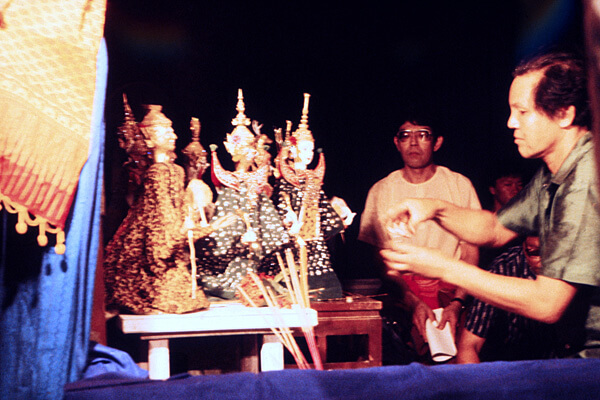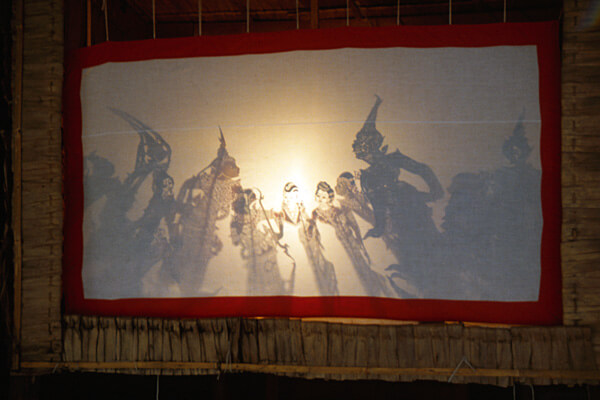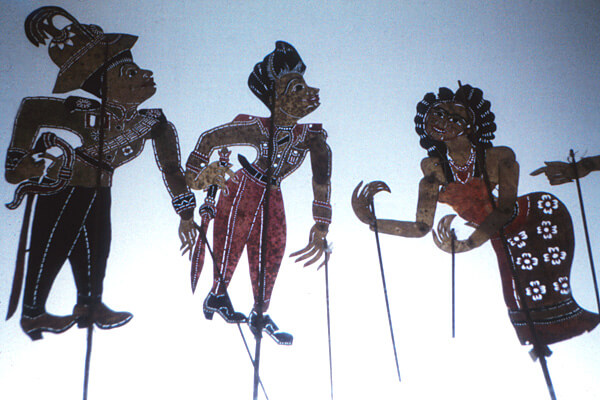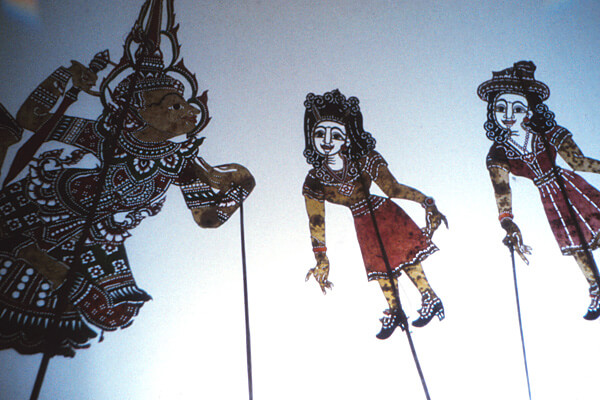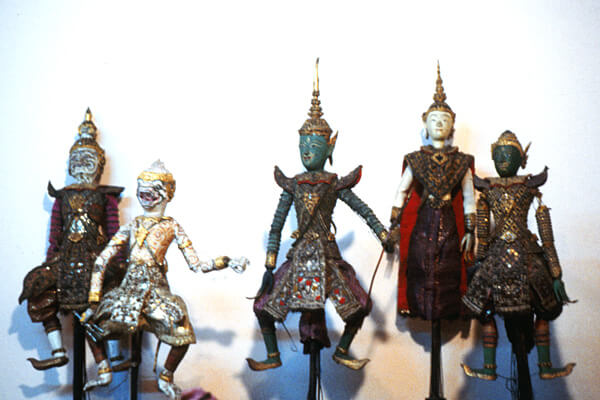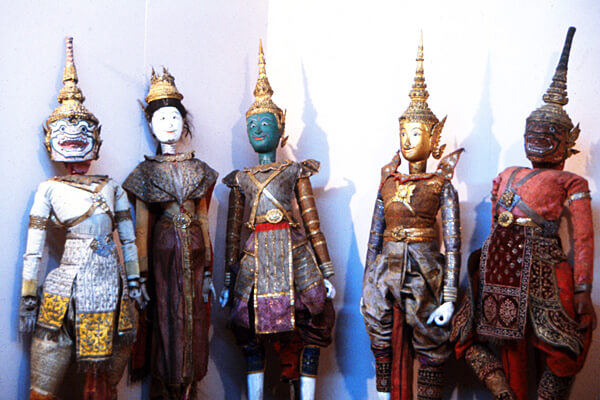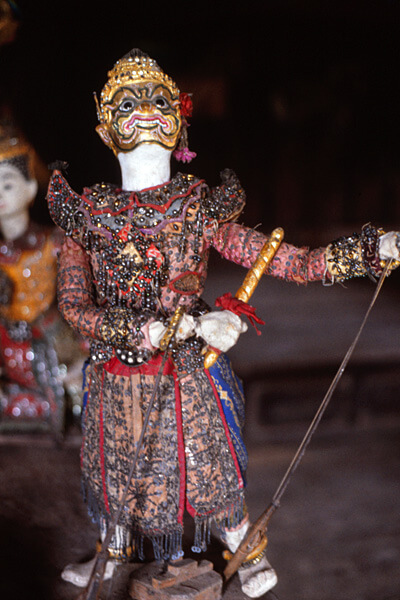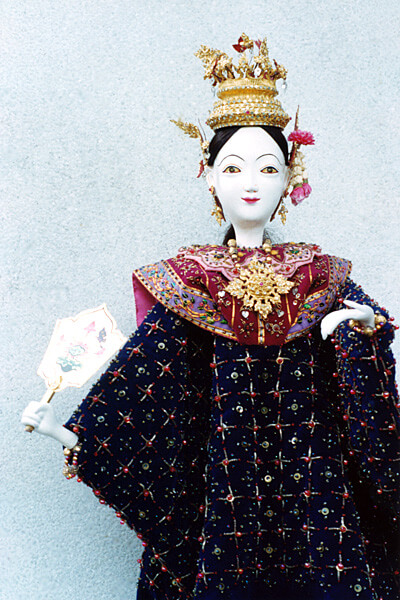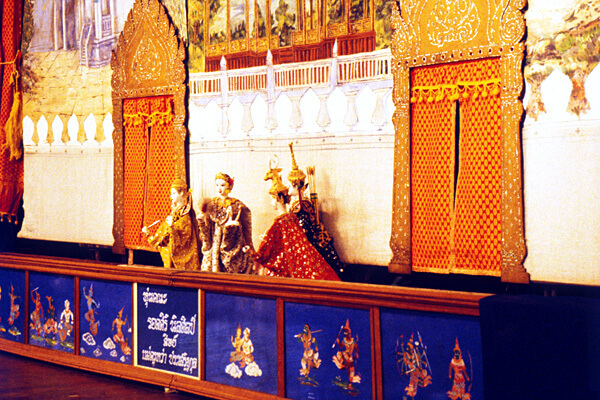Forms of Puppet Theatre, Nang Talung and Variants of Hun
Along with the ancient nang yai shadow theatre, already described earlier, Thailand is the home of two other forms of puppet theatre, the southern nang talung shadow theatre and the three-dimensional puppet theatre hun, with its several sub-categories. In these forms of drama the repertoire is mostly derived from the Ramakien. However, nang talung and hun have had to adapt to the tastes of their audiences, and other stories have also been included in their repertoire.
- A offering ritual for the puppets Jukka O. Miettinen
All forms of puppet theatre have retained ritual elements, such as the initial prayers and offerings to the puppets.
Nang Talung
The nang talung shadow puppets of South Thailand vary in size from 15 centimetres to almost 50 centimetres. They are made of translucent calf hide, painted in bright colours. The figures are usually cut in full-face form, unlike, for example, the puppets in Indonesian shadow theatre, which are mostly shown in profile. In most cases, at least one limb, but often several limbs as well, can be manipulated, unlike the situation in the ancient nang yai, where the puppet is a static image.
- Nang talung shadow theatre from southern Thailand Jukka O. Miettinen
Older existing puppets display a typological development from solemnly decorative nang yai-related figures to a less restricted comic-strip style. Along with the Ramakien the repertoire of nang talung includes plots borrowed from likay folk opera and even from the cinema, and the puppets may portray Western officers, operetta heroes and heroines, or even cowboys.
- Nang talun puppets, on the left Western colonial officers, on the right a local beauty Jukka O. Miettinen
- Nang talung puppets, on the left a traditional figure from the Ramakien, on the right Western characters Jukka O. Miettinen
The popular characters are the stock clowns, such as Ai Nol, Ai Tong, Al Muang, and Ai Klang. They offer obscene humour, often characteristic of nang talung and always loved by the audience. Each has its own characteristics: one constantly moves its mouth, while another has a phallus-shaped index finger, and a third has features of southern Thai aboriginals.
Nang talung requires a group of some ten performers, including the leader, who usually acts as the main manipulator and narrator, his assistants, and the orchestra. The stage used to be a small hut of bamboo, matting, or corrugated iron. The puppeteers and the orchestra sit inside the hut and they are separated from the audience by a white screen. Nang talung is still performed in the Pattalung district of Southern Thailand, although cinema and television have eroded its former popularity.
Types of Hun
Video clip: Hun performance Veli Rosenberg
The nang talung puppets are often simply, or even coarsely, executed. On the other hand, the three-dimensional, rod-operated hun puppets reflect the aesthetics of classical dance and the khon mask theatre. They are sometimes even made by the same artisans who make the khon masks. The material for the puppets is either wood or lacquered papier maché, which is the material for the khon masks as well. The costumes, gestures, and movements of the puppets imitate classical dance.
- Hun lek puppets in the collection of the Bangkok National Museum Jukka O. Miettinen
- Hun luang puppets in the collection of the Bangkok National Museum before their restoration Jukka O. Miettinen
Hun was originally popular even at the court, as shown by the impressive collection of puppets in the National Museum in Bangkok. The large court puppets or hun luang were used in the first part of the 19th century. They are some one-metre tall and they were operated with strings from below. The exact technique of their complicated manipulation is no longer known. The repertory of hun luang included Ramakien and local epics such as Phra Aphaimani, discussed earlier.
In the latter part of the 19th century King Rama V ordered smaller puppets made by the Chinese community of Bangkok. These puppets, some 40 centimetres high, are called hun lek and they were intended for performances derived from Chinese repertory. Their complicated mechanism was modelled on the larger hun luang puppets. In the 1880s Thai-style hun lek puppets were also created. Their repertory included Ramakien and Thai epics performed in the lakhon nai and lakhon nok styles, from which they also derived their performance practices and music.
- A hun lakhon lek puppet in the collection of the Muang Boran Museum Jukka O. Miettinen
- Nang Sida (Sita), a hun krabok doll Jukka O. Miettinen
In the early 20th century a new form of puppet theatre was created. It was hun lakhon lek and it was performed for ordinary audiences. The puppets are some 50 centimetres high and they are operated from below with bamboo sticks. The audience can see the mechanism as well as the dance-like movements of the puppeteers, which make hun lakhon lek a kind of combination of puppet theatre and dance-drama. The repertory includes scenes from the Ramakien, although comical elements are often emphasised more than, for example, in khon.
Another form of popular puppet theatre created in the 20th century is hun krabog. The puppets are some 50 centimetres high, but they have no movable arms or legs. Their hands, manipulated by bamboo rods, protrude from the cloak-like costume of the puppet, which also forms the puppet’s body. Thus the manipulation of the puppet is simpler compared with the complicated court puppets. Hun krabog is still performed and its repertory includes Ramakien as well as other Thai epics.
- Members of the Siam Puppet Group demonstrate the manipulation of the hun krabok puppets of Pha Ram (Rama) and Nang Sida (Sita) Jukka O. Miettinen
- A hun krabok stage Jukka O. Miettinen
Thai puppet theatre has been revived in the late 20th century. Different forms of puppet theatre have been regularly performed at several festivals. The Joe Louis Puppet Theatre has created its own version of Thai puppet theatre by combining it with elements of Japanese bunraku puppet theatre in which three puppeteers manipulate one doll. The company has its permanent stage in Bangkok. Another group making experiments with traditional puppetry is the Siam Puppet Theatre. In its productions puppeteers dance while, at the same time, manipulating the large hun luang-type puppets with strings from behind.
